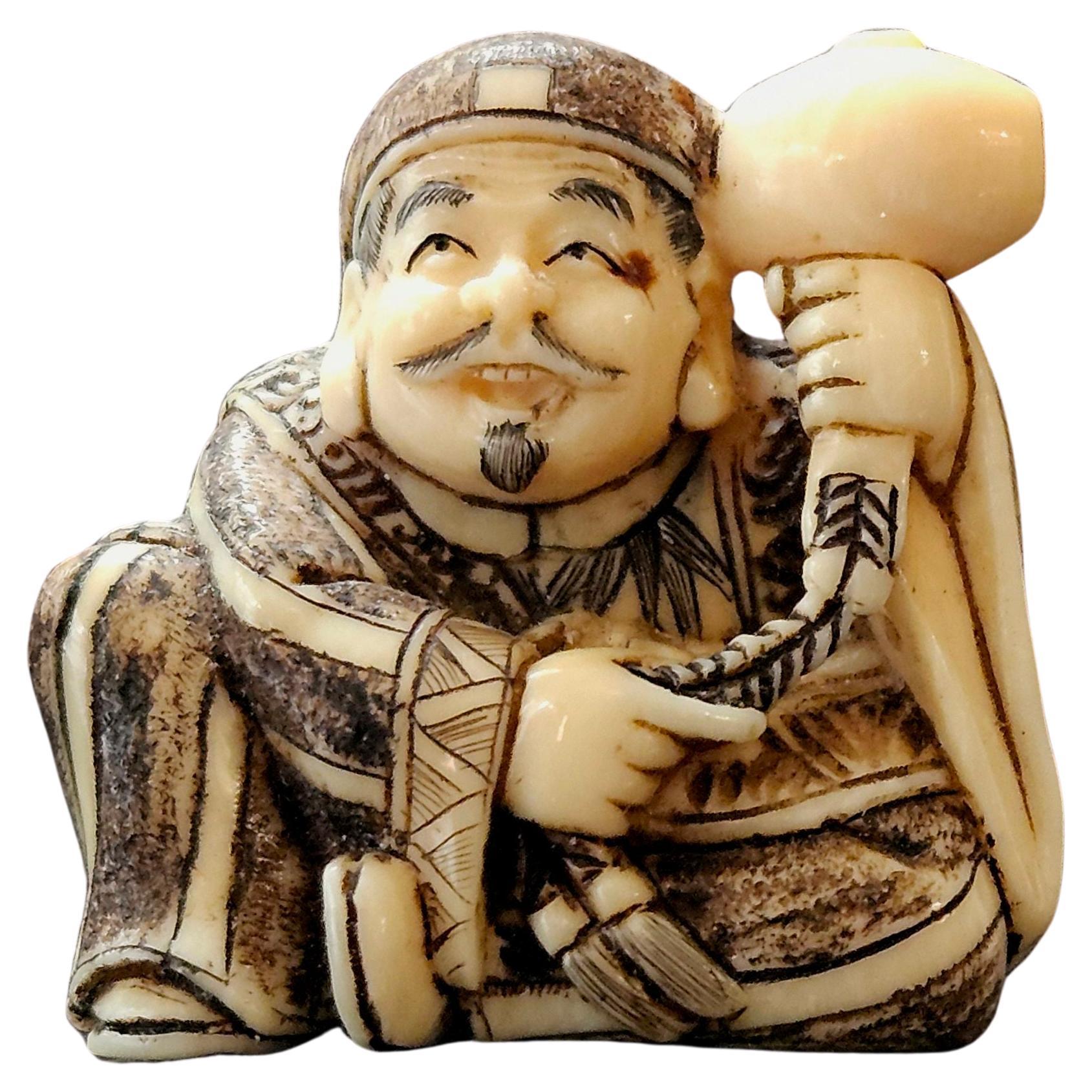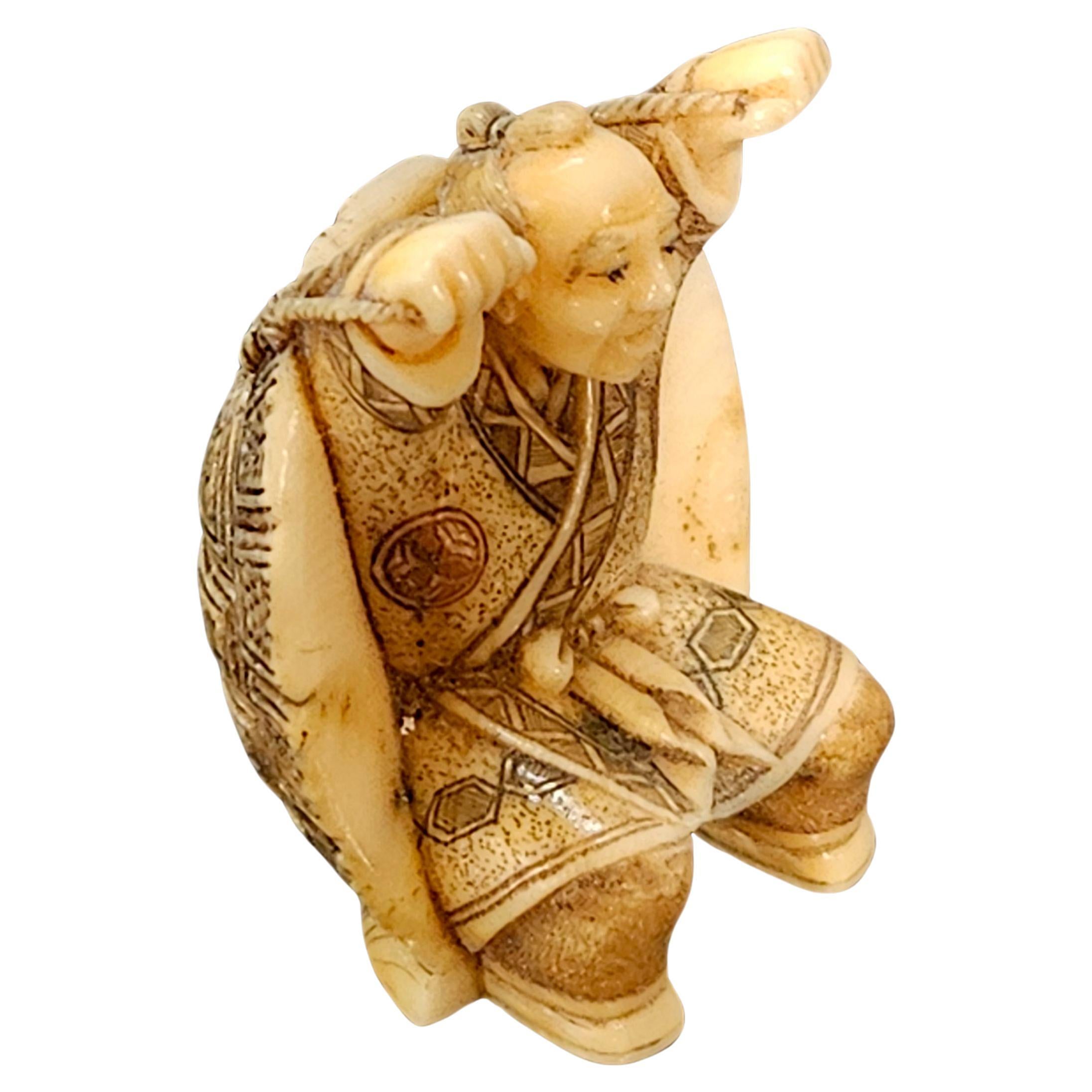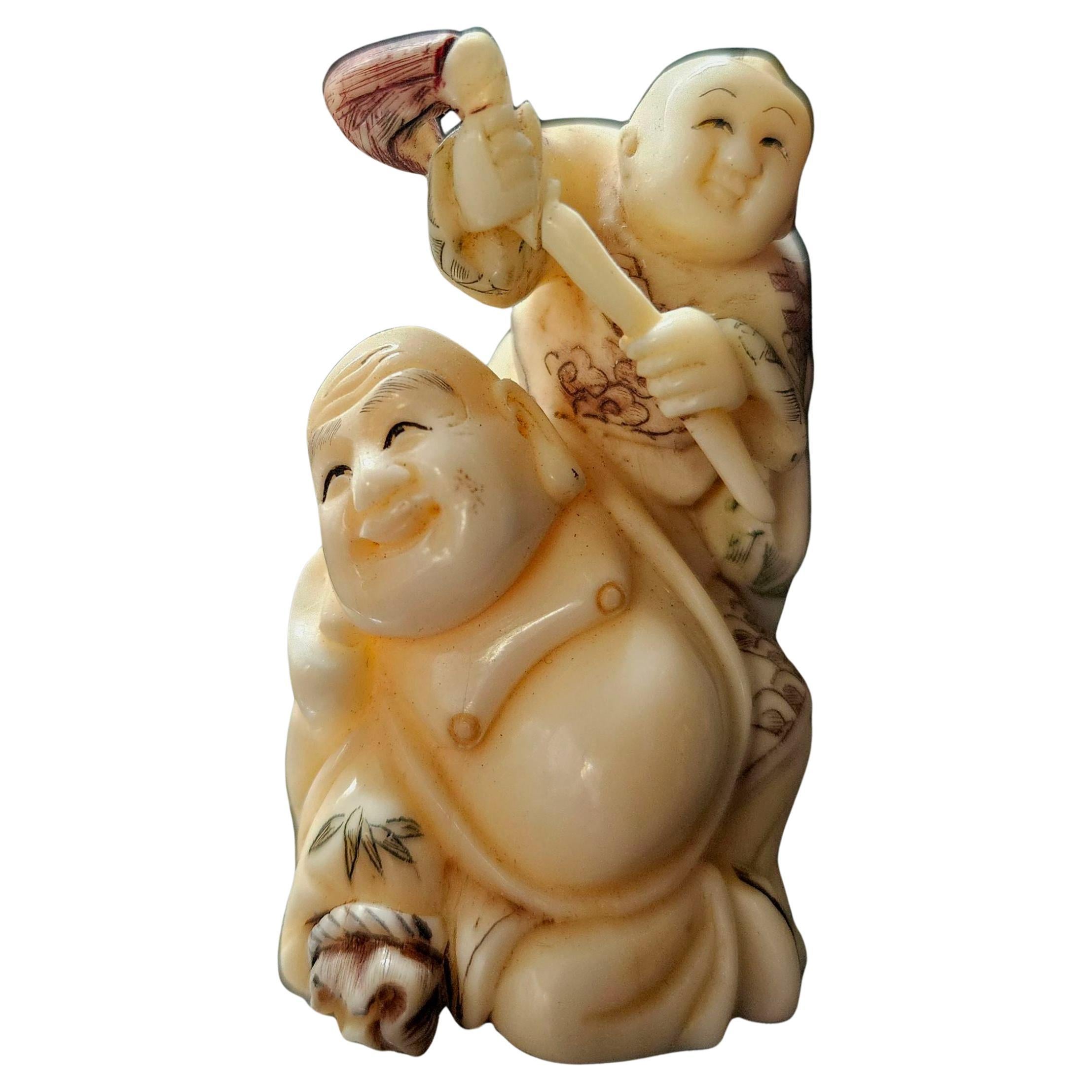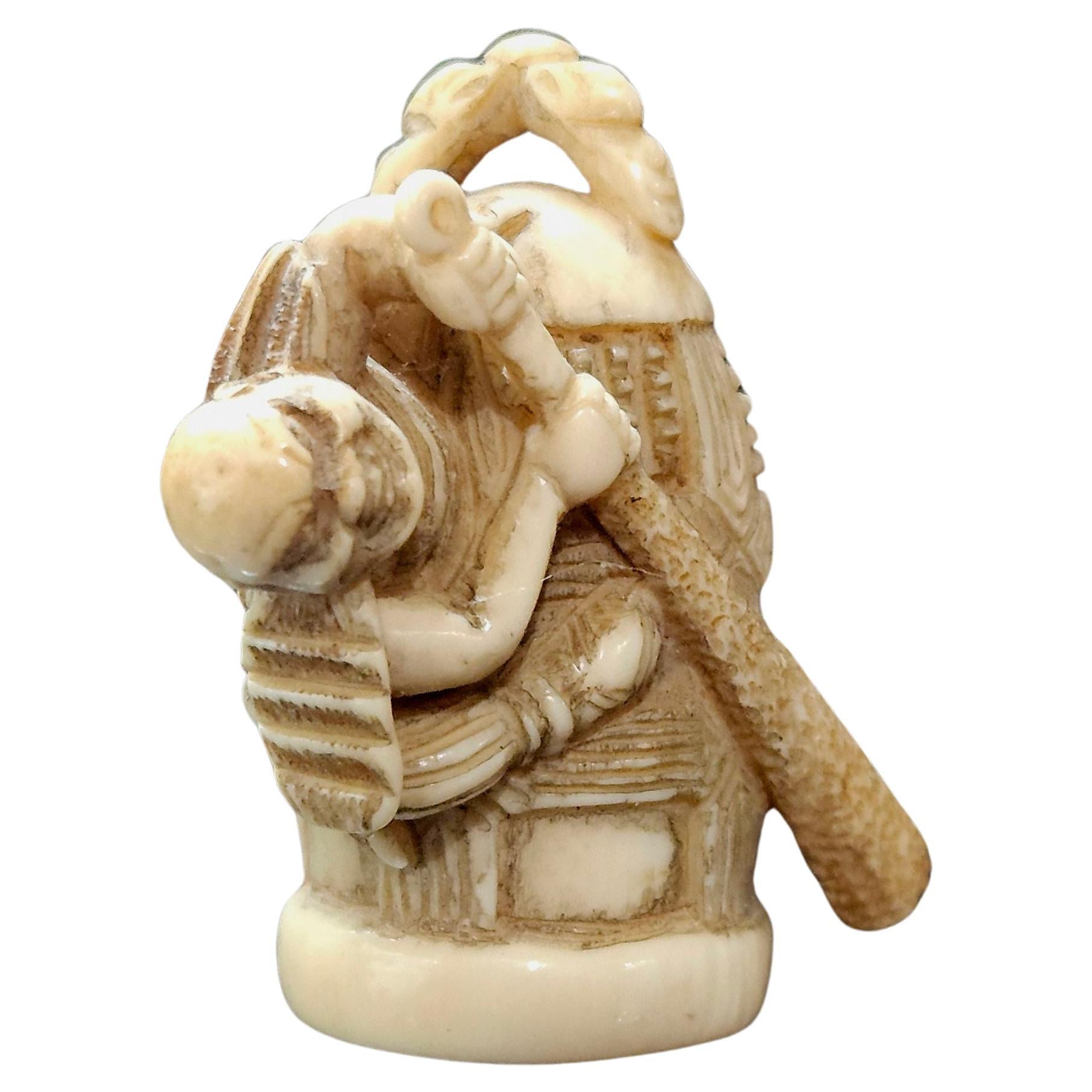Items Similar to Japanese Carved Netsuke Polychrome Figure by Gyokushi (玉芝), Edo Period
Video Loading
Want more images or videos?
Request additional images or videos from the seller
1 of 14
Japanese Carved Netsuke Polychrome Figure by Gyokushi (玉芝), Edo Period
About the Item
Netsuke Japanese Hand-Carved Polychrome Decorated Figure, Signed by Gyokushi (玉芝), Edo Period.
A truly hand-carved ivory figure, A man is lifting a weight. It looks like he is challenging himself for his strength, which shows a museum quality.
This item is 1.75" wide x 1.5" deep x 1.25" high in dimension, from the late 19th century, a great piece of art.
This item is in excellent condition with no damages.
Shipping Note: USA only, no International shipping
The Essence of Netsuke:
Like all art objects of great worth, netsuke distills the essence of a specific time and place. Worn as part of a traditional Japanese man’s ensemble from the 17th century onwards, the netsuke’s purpose was hyper-specific, and its functional simplicity lent artists unlimited freedom to constantly redefine what it could be.
Formally, netsukes have few requirements: they must be small, they must have holes through which to pass a single cord, and they must have no protuberances that could damage one’s kimono. Everything else is left to the carver’s imagination. As such netsuke differs in style, subject, and material as widely as the personalities of their makers, and they are consequently supremely collectible.
Netsuke emerged as a practical solution to dressing in 17th-century Japan. ‘Men’s kimonos didn’t have sewn-up sleeves — they were completely open, front and back, and that meant that the sleeves couldn’t be used as a pocket, as they could in women’s kimonos,’ Goodall explains. To carry things such as tobacco, medicine, or other necessities, men hung stylish inro and other vessels from cords looped under and behind the wide sashes that held their kimonos in place. At the other end of those cords, men fastened small, ornamental objects as counterweights; those objects evolved into netsuke.
The netsuke’s origins are still ‘theoretical’, Goodall says. ‘It’s thought that, with increasing imports from China in the late 17th and early 18th centuries, the toggles that were used on Chinese clothing were imported,’ she explains. Those toggles may have spawned the netsuke.
But the netsuke we know today is a distinctly Japanese art form. ‘As the form developed, and as the netsuke carvers began to compete with each other to come up with new and different ways of handling netsuke, then it became a localized art form that did not relate to anything in China,’ Goodall says. ‘It had completed its evolution by the 19th century.’
Much like jewelry, watches, and handbags today, netsuke were worn to match different occasions and ensembles. Japanese men who could afford them amassed netsuke to diversify their wardrobes.
Still, as Japanese fashion became more influenced by the West, netsuke disappeared from everyday use. Westerners took up the collector’s mantle. ‘In the Meiji period, right after Japan opened to the West in 1854, Americans and Europeans discovered netsuke and immediately started collecting them,’ Goodall says. ‘Westerners were so intrigued by netsuke that carvers continued to make a living by selling them to Westerners.’
- Dimensions:Height: 1.25 in (3.18 cm)Width: 1.75 in (4.45 cm)Depth: 1.5 in (3.81 cm)
- Materials and Techniques:
- Place of Origin:
- Period:
- Date of Manufacture:19th Century
- Condition:Wear consistent with age and use. Wear consistent with age and use.
- Seller Location:Norton, MA
- Reference Number:1stDibs: LU5848239614222
About the Seller
5.0
Platinum Seller
These expertly vetted sellers are 1stDibs' most experienced sellers and are rated highest by our customers.
Established in 2000
1stDibs seller since 2021
87 sales on 1stDibs
Typical response time: <1 hour
- ShippingRetrieving quote...Ships From: Norton, MA
- Return PolicyA return for this item may be initiated within 3 days of delivery.
More From This SellerView All
- Japanese Carved Netsuke Polychrome Figure by Matsuyoshi松吉 Meiji PeriodLocated in Norton, MANetsuke Japanese Hand-Carved Polychrome Figure depicts a man holding a large hammer, Signed by Matsuyoshi 松吉 on the bottom from the Meiji period. A truly hand-carved ivory figure wit...Category
Antique 19th Century Japanese Decorative Boxes
MaterialsIvory, Paint
- Japanese Carved Netsuke Polychrome Figure Group"The Turtleman" Signed , EdoLocated in Norton, MANetsuke Japanese Hand-Carved Polychrome Figure Group depicts a man carrying a title shell, signed on the bottom from the Edo Period. A truly hand-carved ivory figure with fine crafts...Category
Antique 19th Century Japanese Decorative Boxes
MaterialsIvory, Paint
- Japanese Carved Netsuke Polychrome Figure "Sumo" Signed, Meiji PeriodLocated in Norton, MANetsuke Japanese Hand-Carved Polychrome Decorated Figure "Sumo", depicting a strongman holding a big rope and pulling something, signed on the bottom from the Meiji period. This it...Category
Antique 19th Century Japanese Decorative Boxes
MaterialsIvory, Paint
- Japanese Carved Netsuke Polychrome Figure Group #2 by Yoshikawa , MeijiLocated in Norton, MANetsuke Japanese Hand-Carved Polychrome Figure Group #2 by Yoshikawa "The Happy Buddha and a Kid" #H1, Signed on the bottom from the Meiji period. A truly hand-carved ivory figure wi...Category
Antique 19th Century Japanese Decorative Boxes
MaterialsIvory, Paint
- Japanese Carved Netsuke Polychrome Figure Group #1 by Yoshikawa , MeijiLocated in Norton, MANetsuke Japanese Hand-Carved Polychrome Figure Group #1 by Yoshikawa "The Happy Buddha and a Kid" #H1, Signed on the bottom from the Meiji period. A truly hand-carved ivory figure wi...Category
Antique 19th Century Japanese Decorative Boxes
MaterialsIvory, Paint
- Japanese Carved Netsuke Polychrome Figure Group by Gyokuseki (玉石) , MeijiLocated in Norton, MANetsuke Japanese Hand-Carved Polychrome Figure Group depicts a man holding a large cudgel and twining around a big bell, Signed by Gyokuseki (玉石) on the bottom from the Meiji Period...Category
Antique 19th Century Japanese Decorative Boxes
MaterialsIvory, Paint
You May Also Like
- Antique Japanese Inro by Shigehide Edo PeriodLocated in Atlanta, GAThis exquisite four-case lacquered inro was dated to the latter part of 18th century to early 19th century (Edo period) and made by Shigehide. The opposite sides of the inro together features a lavish flower arrangement in a bamboo basket (ikebana). The detailed craftmanship was a true pleasure to behold. Mostly Takamaki-e (high relief) were used to texturize the delicate petals of the chrysanthemums, on which different shades of gold were used to create contrast. Raden (mother of pearl) shells were also used to highlight some leaves, rendering the piece an interesting balance of color and material. The interior was completed in a mottled gold finish. It was signed Shigehide on the bottom with a Kao. There is a small carved rabbit ojime bead...Category
Antique Late 18th Century Japanese Japonisme Lacquer
MaterialsWood, Lacquer
- Japanese Inro by Koma Koryu Edo PeriodLocated in Atlanta, GAA four-case lacquered inro by Koma Koryu circa 19th century late Edo period. The inro features a pair of Chinese mandarin duck resting under a bundle of blooming irises on the pond. ...Category
Antique 19th Century Japanese Japonisme Lacquer
MaterialsWood, Lacquer
- Japanese Lacquer Maki-E Scroll Box Fubako by Kansonsai Edo PeriodLocated in Atlanta, GAA Japanese lacquered wood fubako (a box to store document or small scroll painting) circa late 18th century of Edo period. The rectangular box features a deep lid with rounded corners and recessed mid-edge and a lower box with two bronze medallion rings and tasseled silk ties. The surface of the fubako was elaborately decorated with hiramaki-e and a low takamaki-e on a mottled Mura-nashiji background. The motifs on the lid depict branches of Japanese pine with finely rendered needles on the lower part; on the upper part, it showcases fruited persimmon branches. Two different shades of gold fundame were used to contrast the design and augmented by scattered gold kirigane to highlight some of the leaves. The design continues and cascades down to all sides of the lid as well as the walls of the box. The two bronze medallions appear original to the box and the silk ties show significant fading from the age. This Fine fubako is signed on the lower wall "Kanshosai" in Kanji with a kao mark. All the trims were finished in gold fundame and the interiors a dense nashiji in gold. Kanshosai is the mark of the distinguished lacquer artist Lizuka Toyo I who also signed his work "Toyosai". He was active in the second half of the 18th century during Edo period, employed by Hachisuka Shigeyoshi (1738-1801), daimyo of Awa on Shikoku Island. Although most survived work bearing his marks are inros, he was also known to decorated trays and other larger objects...Category
Antique Late 18th Century Japanese Edo Lacquer
MaterialsWood, Lacquer
- Rare Japanese Sumi-E Lacquer Inro Yamada Jokasai Edo PeriodLocated in Atlanta, GAA three-case lacquered Inro by Yamada Family circa 18th-19th century Edo period. The inro with slight rounded form is of Kano style and vividly depicts a dragon slithering among the ink clouds on a gold background. Sumi-e togidashi (ink togidashi) technique, in combination with Hiramaki-e, were employed to create the dreamy ambience of this piece. The dragon has a painterly appearance inspired by Chinese ink painting that was often seen on the Japanese folding screens. The back of the Inro was sparsely decorated with the shifting patterns of the darkening clouds with an emphasis on the space intentionally left empty. Jokasai was signed to the base. On the front of the inro there is another miniature signature Hakugyoku Hogen, which is one of names used by Kano Michinobu (1730-1790). The dragon is evidently one of his designs (see reference below). Established by a member of Yamada family in the 17th century, the clan was one of the most prominent lacquer artisanal family for the next 200 years until the end of Edo period in the 19th century. Most members signed their work simply with Jokasai making the identification of the individual artists somewhat impossible. The current Inro on offer, compared to many other pieces by Jokasai, has an uncommon Kano style done in Sumi-e togidashi. Another unusual feature of this piece is that the interiors of the inro was decorated with an interesting gold mosaic inlays (kirigane) on a dark lacquer background, giving it a jewel like quality. For another Inro by Jokasai of a similar style using Sumi-e togidashi but depicts a tiger, see Wrangham collection, no.353, which was offered for sale as lot 256 in Bonham's London Auction: The Edward Wrangham Collection of Japanese Art Part I. 9 Nov 2010. For an ink scroll...Category
Antique 18th Century Japanese Japonisme Lacquer
MaterialsWood, Lacquer
- Large Japanese Lacquer Box Early Edo Period Ex-Christie'sLocated in Atlanta, GAA large lacquer Ryoshibako (Paper box in Japanese) finely decorated with Maki-e circa 17th century early Edo period. The box is of an impressive size and was used to store paper documents. Both sides of the lid were elaborately decorated with maki-e and the edge was befitted with lead rim, an early practice before the silver rim became common later. The interior and base were finished in Nashiji. The night scene on top surface of the lid depicts flocks of chidoris flying in formation from a sea shore swaying with reeds under a full moon, using hiramaki-e in both gold and silver. Ribbons of clouds were achieved with different densities of gold powder. The underside, in contrast, shows a crescent moon in takamakie-e above the sea with ferns and reeds. Chidoris, the plovers, are symbolic in Japanese culture as "thousands of blessings" and longevity. The Namichidori, the pattern in which the chidori flies in the nami (wave) represents the eternal love and safety of couples and families. For detailed references on the historical background and the use of chidoris on lacquerware, see the reference below. This very lacquer box was featured for sale as lot 339 in Christie's London Sale Japanese Art...Category
Antique 17th Century Japanese Japonisme Lacquer
MaterialsWood, Lacquer
- Exquisite Japanese Lacquer Maki-e Hand Box Kobako Edo PeriodLocated in Atlanta, GAAn early Japanese lacquer Maki-e decorated kobako (small storage box) circa 18th century (Edo period). Based on its form and size, this kobako was possibly used as a Chabako to store...Category
Antique 18th Century Japanese Edo Lacquer
MaterialsLacquer
Recently Viewed
View AllMore Ways To Browse
Antique Sign Collectors
Men Jewelry Box
Mens Jewellery Box
Mens Jewelry Box
Mens Jewlery Box
Japanese Small Objects
Antique Jewelry Watch
Ivory Carved
Carved Ivory
Chinese Jewellery Box
Chinese Jewelry Box
Chinese Jewlery Box
Carved Painted Figure
Antique Carvers
Box Style Handbag
Japanese Jewellery Box
Hand Carved Ivory
Mens Bedroom





